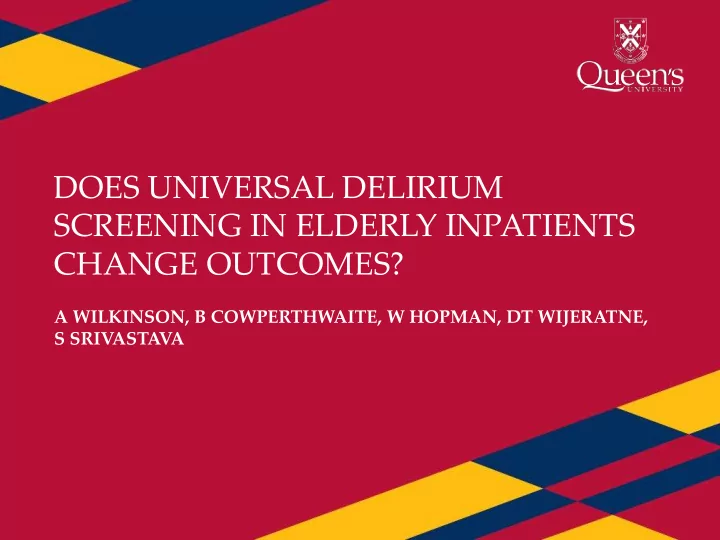

DOES UNIVERSAL DELIRIUM SCREENING IN ELDERLY INPATIENTS CHANGE OUTCOMES? A WILKINSON, B COWPERTHWAITE, W HOPMAN, DT WIJERATNE, S SRIVASTAVA
BACKGROUND • Delirium is a common complication of hospital inpatients – Occurrence rate per admission of up to 42% in patients admitted to general medicine/ elderly care units 1 • Delirium is associated with increased complications: – Increased length of stay 2 – Increased mortality 3 – Increased rates of new nursing home placement 4 • Little data regarding whether universal delirium screening impacts these outcomes
RESEARCH QUESTION Does daily universal delirium screening in medical inpatients greater than 65 years of age affect outcomes (length of stay, inpatient mortality, falls incidence, discharge destination)?
METHODS • Pilot ward: Universal Delirium Screening 7/1/2015 11/1/2015 10/1/2015 1/30/2016 Pre-screening Post-screening cohort cohort • Other Medicine wards: Universal Delirium Screening 7/1/2016 11/1/2016 10/1/2016 1/30/2016 Pre-screening Post-screening cohort cohort
METHODS PRIMARY OUTCOME Inpatient length of stay (LOS) SECONDARY OUTCOMES Inpatient mortality during index admission Inpatient morbidity (falls, delirium, health care associated pneumonia, ICU admission, adverse drug reaction) Transition to assisted living post-discharge
RESULTS • 981 patients – 502 in pre-screening cohort – 479 in post-screening cohort CHARACTERISTIC PRE-SCREENING POST-SCREENING P VALUE Male sex, no. (%) 245 (48.8) 249 (52.0) 0.32 Mean age, years (95% CI) 79.2 (78.5, 79.9) 79.5 (78.7, 80.2) 0.58 Charlson Comorbidity Index (CCI), 3.77 (3.55, 3.99) 3.84 (3.62, 4.06) 0.69 mean (95% CI) Age-adjusted CCI, mean (95% CI) 7.23 (7.00, 7.66) 7.31 (7.07, 7.55) 0.64 Independent Living Situation, no (%) 396 (78.9) 377 (78.7) 0.56
RESULTS CHARACTERISTIC PRE-SCREENING POST-SCREENING P VALUE Median LOS, days (range) 5.0 (1 – 340) 5.0 (1 – 372) 0.55 Inpatient mortality, no. (%) 40 (8.0) 42 (8.8) 0.65 Falls, no. (%) 29 (5.8) 14 (2.9) 0.03 Hospital-Associated pneumonia, no. 9 (1.8) 4 (0.8) 0.19 (%) Adverse Drug Reaction, no. (%) 57 (11.4) 49 (10.2) 0.57 Delirium occurrence, no. (%) 92 (18.3) 76 (15.9) 0.31 ICU Admission, no. (%) 20 (4.0) 17 (3.6) 0.72 Requirement for increased living 48 (9.6) 33 (6.9) 0.13 support, no (%)
RESULTS • Sensitivity Analysis: – Performed random chart audit during delirium screening period – Mean compliance rate with daily CAM screening: 73% (Range 44- 96%) Delirium Screening Compliance Rate (2015) 100% 90% 80% 70% 60% 50% 40% 30% 20% 10% 0% 21-Oct 31-Oct 10-Nov 20-Nov 30-Nov 10-Dec
RESULTS • Univariate Analysis: – Patients who developed delirium were older • Mean age 82.21 vs. 78.74 years old (p < 0.001) – Patients requiring ICU admission had higher mean CCI • Mean CCI 4.86 vs. 3.76 (p=0.009) – Patients who were older were more likely to develop any adverse outcome (excluding mortality) • Mean age 79.97 vs. 78.82 (p = 0.033) – Patients who had higher CCI were more likely to develop any adverse outcome (excluding mortality) • Mean CCI 4.02 vs. 3.62 (p=0.013) – Patients requiring assisted living at baseline were more likely to develop any adverse outcome (excluding mortality) • 52.2% vs. 41.9% (p=0.002)
RESULTS • Univariate Analysis: – Patients in the pre-screening cohort were more likely to develop any adverse outcome (excluding mortality) • 55.0% vs. 45.0% (p=0.03)
CONCLUSION • Delirium screening was associated with decreased incidence of falls, and decreased incidence of any adverse secondary outcome (excluding mortality) • Delirium screening did not affect the primary outcome, mean inpatient LOS • Delirium screening did not affect any of the following secondary outcomes – Inpatient mortality – Hospital associated pneumonia – ICU admission – Adverse drug reaction – Delirium occurrence – Requirement for increased living support post-discharge
DISCUSSION • No prior studies have examined delirium screening itself (without targeted intervention) • Rates of delirium no different between pre-screening and post-screening cohorts (18.3% vs. 15.8%) – Occurrence rates lower than in similar study populations, although within range (11-42%) 1 – Incidence rate of delirium on sensitivity analysis: 14% (range 4-21%)
REFERENCES 1. Siddiqi N, House AO, Holmes JD. Occurrence and outcome of delirium in medical inpatients: a systematic literature review. Age Ageing. 2006;35(4):350-364. 2. McCusker J, Cole M, Abrahamowicz M, Primeau F, Belize E, CK C. Delirium Predicts 12-Month Mortality. Arch Intern Med. 2002; 162(4):457 3. O’Keeffe S, Lavan J. The prognostic significance of delirium in older hospital patients. J Am Geriatr Soc. 1997;45(2):174-178. 4. Inouye SK, Rushing JT, Foreman MD, Palmer RM, Pompei p. Does delirium contribute to poor hospital outcomes?: A three-site epidemiological study. J Gen Intern Med. 1998;13(4):234-242.
Recommend
More recommend